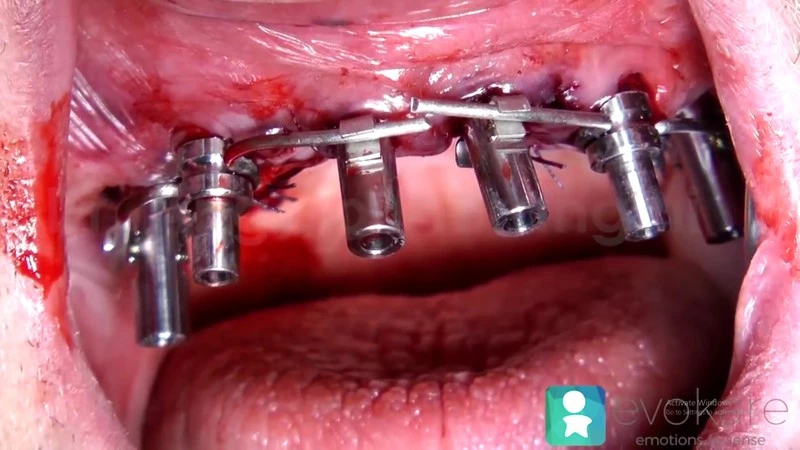All-On-4 after 5 Years
A group of dental researcher from Italy conducted a clinical study with 5-year follow up to evaluate the use of prefabricated bar for All-on-4, immediate-loading implants in edentulous patients.
Prior to surgery by 1 hour, the patients received 2 g amoxicillin; then they were prescribed 1 g twice daily for 1 week after surgery. In addition, nonsteroidal anti-inflammatory drug and chlorhexidine digluconate 0.2% mouthwash during the first 2 weeks after surgery were prescribed.
In edentulous mandibular arches, incisions were made on top of the alveolar crest, from the first molar on one side to the first molar on the contralateral side with bilateral releasing incisions while the mental foramina were located. The most distal implants (diameter= 4.5mm; length= 13–15mm) were placed 1-2mm to the anterior wall of the mental loop, tilted distally by average 25 degrees from the occlusal plane and emerged at the position of the second premolar. The anterior implants (diameter= 3.8–4.5mm; length= 13–15mm). Bone contouring/shaping was performed in some cases using round bur for leveling the crestal bone to allow for angled implants’ placement.
In edentulous maxillary arches, incisions were done in the same fashion. Subperiosteal dissection was carried out. The most distal implants (diameter= 4.5mm; length= 13–15mm) were placed 1-2 mm away from and parallel to the anterior sinus wall. The anterior implants (diameter= 4.5–3.8mm; length= 15–13mm) were tilted distally in average 25 degrees with their necks positioned at bone level.
Soft bone underpreparation was done in order to obtain high primary stability. As implants were in immediate function, the final insertion torque ranged between 30 and 40 N/cm. Angled abutments for anterior implants were adjusted in 17° and for posterior implants were adjusted in 30° to compensate for the unparalleled implants and to place the prosthetic screw-access holes in an occlusal or lingual orientation. The angled abutments were tightened with a torque of 25 N/cm.
Straight cylinders were screwed on the angled abutments. The distance between the implants was measured and 3 bar tubes were shortened to the measured length. 2 bar joints were inserted at the end of each tube in order to connect the transverse bars to the cylinder. The cylinders were as high as to allow the bar to lay parallel to the occlusal plane. The joints were connected to the cylinders and fixed by resin cements. No soldering was performed as the ball and joint is universal and allows the tube bar to be placed in a horizontal plane with stress-free alignment. The prostheses were passively seated, had 4 large openings designed as the planned cylinder emergence and connected to the bar system with self-curing acrylic resin for impression. The prostheses with the bar system were removed from the implants. Then, retention, marginal precision and stability were improved by adding resin around the collar of the cylinders.
Screw-retained full-arch temporary prostheses were placed and cantilevers were extended to the first molar region or just to the second premolar.
After final prostheses, the patients were asked to follow a soft/liquid diet for average 2 months (the bread consistency varied). Follow-up visits were performed by dental hygienists for assessment after 3, 6, 12, 24, 36, 48 and 60 months. Success criteria for implant survival were implant stability as well as absence of radiolucent zone around the implants, mucosal suppuration or pain.

Overall, 1 case of implants’ failure was reported; it was an axial failure without compromising prosthetic function. A new implant with the same length, larger diameter was placed immediately placed but left unloaded for 2 weeks. The 5-year implant survival rate was 100% for axially positioned implants and 98.44% for tilted implants. The implant survival rates were 100% in the maxilla and 98.75% in the mandible. None of the 32 fixed prostheses were lost during the observation period, so the prosthetic survival rate of 100%. The main complication was occlusal screw loosening in 3.03% (4 implants) of cases in 6-month follow-up.

